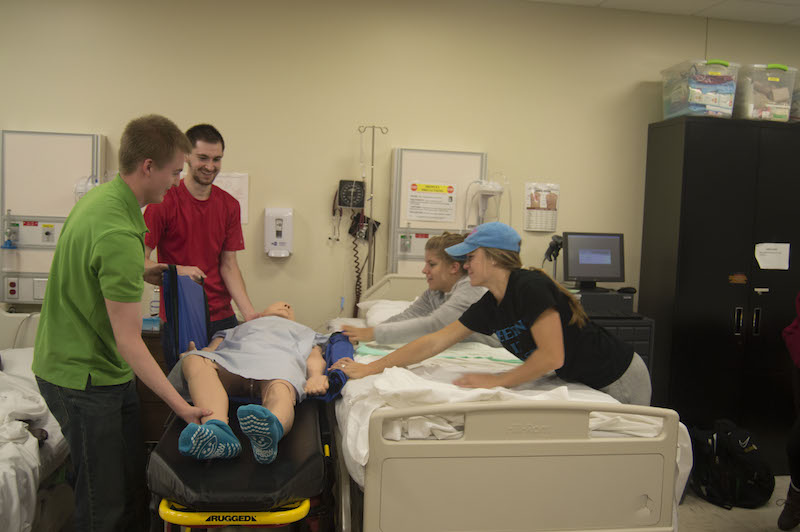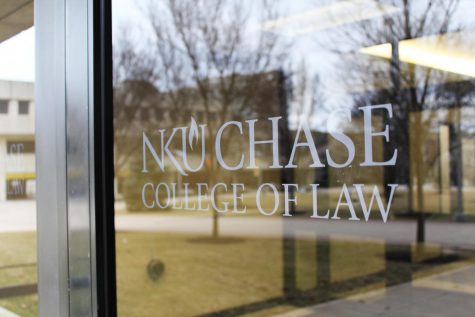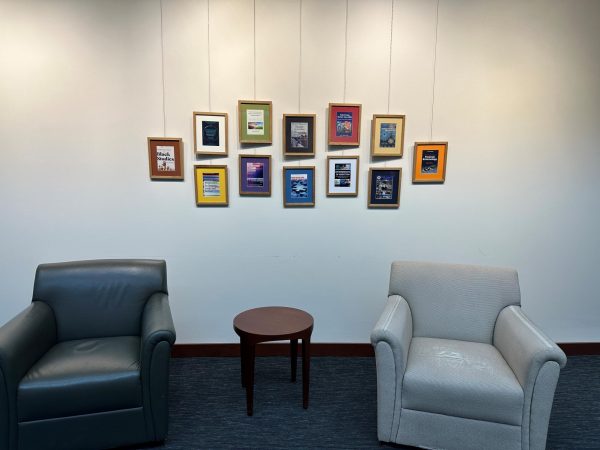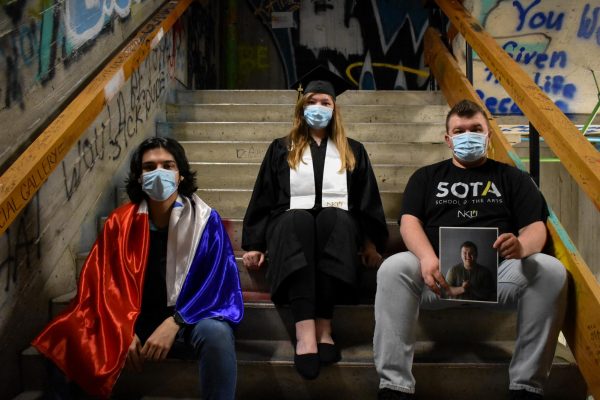HIC to offer learning through collaboration
First-year nursing students transfer a mannequin in a skills lab.
Labs that simulate an operating room, mannequins that can be programmed to stop breathing and exam rooms to evaluate standardized patients are all possibilities of the new Health Innovation Center.
Students from across several disciplines will benefit from the collaborative spaces of the facility.
The HIC will allow the university to expand and add programming in more than just health professions. Existing programs such as social sciences, informatics, arts, humanities and education will be enhanced through the center.
“I think the most exciting part is that all the colleges will have the opportunity to be a part of this new building,” Dr. Dale Scalise-Smith, dean of health professions, said. “We’ll have programs from across the campus that will allow us to really integrate student knowledge and student learning.”
The five-story facility boasts 205,000 gross square feet with 135,000 assignable square feet which will house various research and teaching labs, technology-rich classrooms, learning studios, simulation rooms and exam rooms for clinical skills students.
“There’s a lot of common space that will invite conversation and group work and brainstorming and presentations,” Sue Ott Rowlands, provost and executive vice president for academic affairs, said. “And that’s all the way throughout the building; the cafe, the atrium area, the very transparent conference rooms, and even the seating areas.”
Ott Rowlands said that the new programs are possibilities for the time being. She explained that the programs must be granted approval at the university and state level before they can be implemented.
As the HIC is not expected to be completed until May 2018, the additions of programs, as well as the names of programs and spaces within the facility are tentative and subject to change.
Ott Rowlands said that ideally the neuroscience minor will expand into a major, as the facility will provide space for several research and teaching labs in neuroscience and psychological sciences. The building will also feature an expanded vivarium area for animal research.
These areas could potentially facilitate a graduate certificate in neuroscience and meditation, an M.S. in decision science, and a minor in addiction science.
The first floor will house the neuroscience labs and vivarium space as well as the kinesiology lab. This space opens up the possibility of a new M.S. in exercise science as well as a new M.S. in kinesiology.
A creative movement lab is also located on the first floor of the facility, as creative arts therapy is a possible B.A. and M.A..
“We will take therapies and the dance and theatre students and really give them another skill-set working with those who are differently enabled,” Scalise-Smith said.
In addition to integrating the health professions with students from the School of the Arts, the College of Informatics will also have a place in the new HIC. A B.A. and a minor in health communication and a B.S. in health informatics are new programs that are a possibility.
“Health informatics will be extremely important for student learning,” Scalise-Smith said. “There’s nothing more important than security of our health information. So a lot of what the experts in the College of Informatics have to offer will be of great service to faculty and students in the program.”
The facility will also house The Transdisciplinary Institute and Innovation Center, which will facilitate an undergraduate degree in health, society and the environment and a graduate degree in health leadership and policy studies. It will also be the home of the Center for Healthcare Policy and Advocacy.
Scalise-Smith said that The Transdisciplinary Institute will not only serve as a space for collaborative thought, but also to help students and faculty members have a better understanding of other professions.
“It’s an interactive opportunity that really brings together all of our disciplines in a way that is focused on population health, improving the overall well-being of the residents of Kentucky, and the Northern Kentucky region, and putting us on the map in the regional landscape to serve as a model for other programs,” Scalise-Smith said.
Levels three and four of the facility will include the clinical skills areas for health professions. The standardized patient simulation center will allow members of the community to be involved in the learning process. Those who participate are trained act as patients with specific symptoms.
Scalise-Smith said that the standardized patient simulation center is imperative in getting students to look at different ways to approach patient care as a healthcare professional.
“It gives you a very safe environment that you can train students,” Scalise-Smith said. “It allows the students to develop not just knowledge, but the skill of interacting with another human being. Listening is a really important aspect of healthcare.”
In addition to the standardized patient simulation center, the facility will also have a second simulation lab, which will feature high-tech mannequins that are controlled by the instructor.
The mannequins are hooked up to a machine that displays their heart rate, blood pressure and respiratory rate. From a mobile simulation pad, they can also be programmed to display different symptoms, such as cardiac arrest or respiratory failure.
All of the simulations are video recorded, so that the students can review the footage of the simulations in debrief rooms.
Scalise-Smith explained that the simulation labs and debrief rooms are a unique part of the facility, as the different methods of teaching accommodate a variety of ways in which students learn.
The HIC will also have an operating room simulation center, which can also be transformed into an emergency room.
“That really allows us to simulate some sort of a crisis, and look at how the professionals would work together in such a situation,” Scalise-Smith said.
Along with simulation labs, The Activities of Daily Living Lab will provide students with real-world practice in patient care. This lab will serve programs such as an M.S.N. in healthy aging and new doctoral programs like occupational therapy or physical therapy.
According to Ott Rowlands, the lab will be set up like a small apartment with a kitchen and bathroom area. Students will be able to use this space to learn how to assist the elderly or those who are physically handicapped in a home environment.
The university is considering utilizing the fifth floor of the building as a space for a doctorate program in either physical therapy or occupational therapy.
“We’re so fortunate as an institution to have the opportunity to build this because we can so impact the future of the residents of Kentucky in a positive way,” Scalise-Smith said.
All current plans for the Health Innovations Center are tentative and subject to change.













